Physical Address
304 North Cardinal St.
Dorchester Center, MA 02124
Cardiothoracic surgery is one of the newer surgical specialities that has undergone massive expansion and subspecialisation in the last few years. Although these could be considered two distinct specialities, cardiac and thoracic surgery remain closely related with common pathologies and practices.
The classical pain of coronary artery disease (CAD) is normally central crushing chest pain radiating to the jaw or left arm associated with nausea and occasionally vomiting; however, many patients present with atypical pain. The class of angina is normally described using the Canadian Cardiovascular Score depending on the level of activity to trigger the pain. Valve disease, on the other hand, is not painful but presents in other ways.
Lung cancer occasionally presents as chest pain localised to the side of the disease, as do pneumothoraces and empyemas. Pleuritic chest pain is typical of pleural irritation secondary to infection in the lungs or the pleura itself, or due to malignant involvement.
Shortness of breath can be multifactorial in cardiothoracic patients and is a symptom of many intrinsic lung diseases. Dyspnoea in patients with chronic respiratory diseases is described using the Medical Research Council Dyspnoea Scale, whereas symptoms in patients with valve conditions and heart failure are described using the American Heart Association classification.
Loss of consciousness related to exertion can be related to valve disease, especially aortic valve stenosis, when the heart cannot increase the cardiac output with exercise to match the increased requirement. The arterial systolic pressure drops due to systemic vasodilatation in the presence of a fixed cardiac output.
Coughing up blood or its presence in coughed-up sputum is a red-flag sign for lung cancer, but it can also be caused by benign lung disease such as aspergillosis or tuberculosis. It may also be a presenting symptom in patients with heart failure.
Accurate evaluation of the risks of perioperative mortality and morbidity is essential in the decision making for surgical intervention, in obtaining informed consent of the patient, for planning of operative lists and also for allocation of resources for postoperative care. Cardiac surgery using the Additive EuroScore, the logistic EuroScore or more recently the Euroscore II ( Table 23.1 ) has the most established risk stratification system of all surgical specialities and has allowed the publication of risk-adjusted mortality rates for individual surgeons. Thoracoscore is the most used risk stratification system for thoracic patients, although there have been numerous publications questioning its validity.
| Patient-related factors | |
|---|---|
| Age | Years |
| Gender | Male/female |
| Renal impairment | Calculate creatinine clearance • On dialysis (regardless of serum creatinine level) • Moderately impaired renal function (50–85 mL/min) • Severely impaired renal function (< 50 mL/min) off dialysis |
| Extracardiac arteriopathy | One or more of the following: • Claudication • Carotid occlusion or > 50% stenosis • Amputation for arterial disease • Previous or planned intervention on the abdominal aorta, limb arteries or carotids |
| Poor mobility | Severe impairment of mobility secondary to musculoskeletal or neurologic dysfunction |
| Previous cardiac surgery | Yes or no |
| Chronic lung disease | Long-term use of bronchodilators or steroids for lung disease |
| Active endocarditis | Patient still on antibiotic treatment for endocarditis at time of surgery |
| Critical preoperative state | • Ventricular tachycardia or ventricular fibrillation or aborted sudden death • Preoperative cardiac massage • Preoperative ventilation before anaesthetic room • Preoperative inotropes or intraaortic balloon pump • Preoperative acute renal failure (anuria or oliguria < 10 mL/hr) |
| Diabetes on insulin | Yes or no |
| Operation-related factors | |
| NYHA | Class of shortness of breath 1–4 |
| CCS class 4 angina | Angina at rest |
| Left ventricle function | • Good (ejection fraction > 50%) • Moderate (ejection fraction 31–50%) • Poor (ejection fraction 21–30%) • Very poor (ejection fraction 20% or less) |
| Recent MI | Myocardial infarction within 90 days |
| Pulmonary hypertension | Systolic pulmonary artery (PA) pressure in two classes • Moderate: PA systolic pressure (31–55 mm Hg) • Severe: PA systolic pressure (>55 mm Hg) |
| Operation-related factors | |
| Urgency | • Elective: Routine admission for operation. • Urgent: Patients who have not been electively admitted for operation but who require intervention or surgery on the current admission for medical reasons. These patients cannot be sent home without a definitive procedure. • Emergency: Operation before the beginning of the next working day after decision to operate. • Salvage: Patients requiring cardiopulmonary resuscitation (external cardiac massage) en route to the operating theatre or prior to induction of anaesthesia. This does not include cardiopulmonary resuscitation following induction of anaesthesia. |
| Weight of the intervention | Include major interventions on the heart such as: • CABG • Valve repair or replacement • Replacement of part of the aorta • Repair of a structural defect • Maze procedure • Resection of a cardiac tumour |
| Surgery on thoracic aorta | Yes or no |
Careful history and appropriate examination suggest the presence of possible cardiac pathology. The initial clinical assessment is then refined and specific investigations used to confirm and quantify any disease identified ( Table 23.2 ).
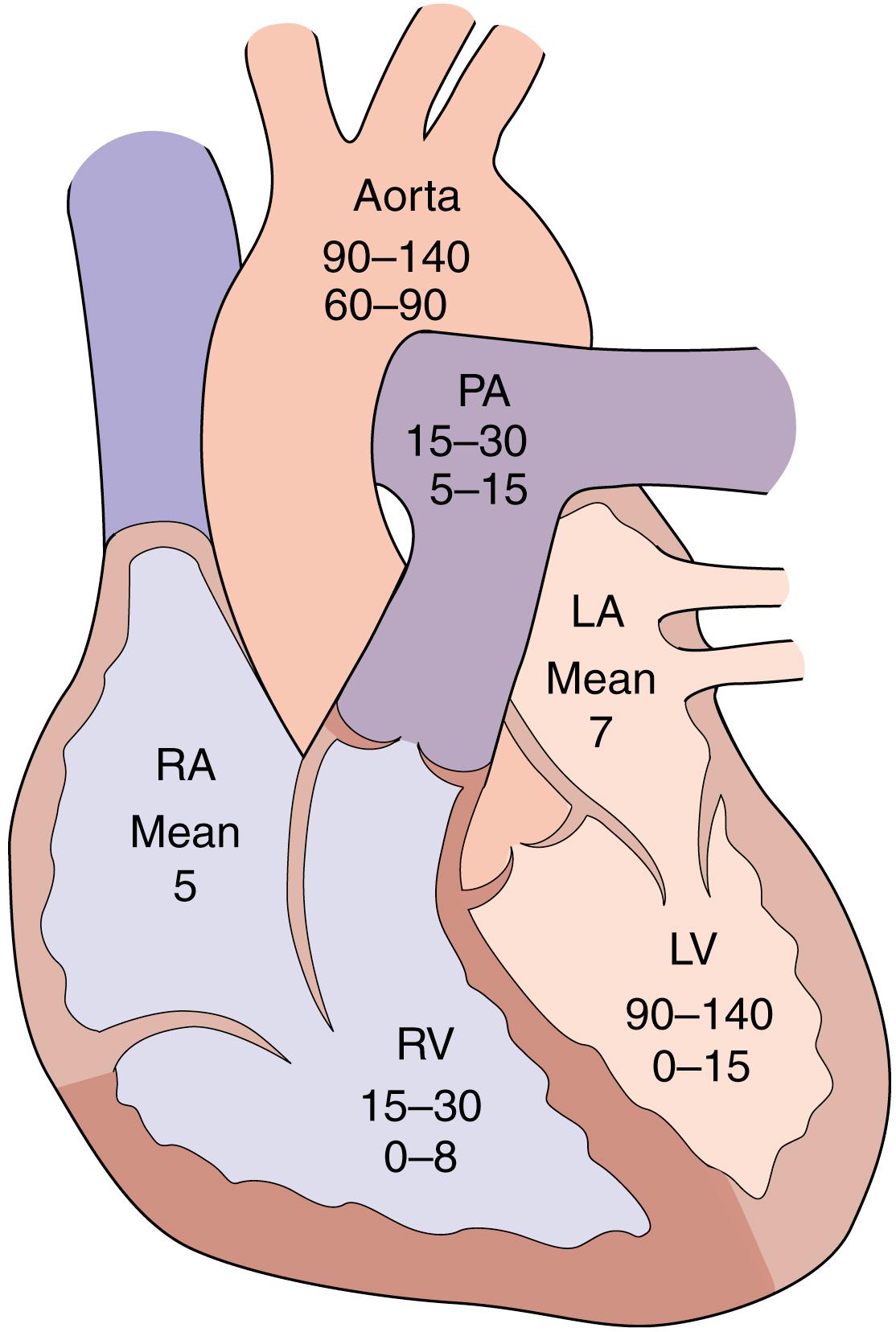
| Investigation | Yield |
|---|---|
| ECG Resting Exercise |
Rhythm; conduction abnormalities; atrial and ventricular hypertrophy; established ischaemic changes; evidence of previous myocardial infarction (MI) Exercise-induced ischaemic changes or arrythmias |
| Chest x-ray | Cardiac enlargement; valvular calcification; evidence of pulmonary oedema (Kerley B lines, pleural effusion, interstitial marking, hilar flare); absent or enlarged cardiac or great vessel structures |
| Thallium isotope scan | Areas of low radio-uptake indicative of impaired myocardial perfusion |
| Echocardiography Transthoracic Transoesophageal |
Ventricular contractility; valvular stenosis, regurgitation or leaflet abnormalities; intracardiac morphology, including septal defects and intracardiac masses; pericardial effusion Enhanced views of posterior cardiac structures (aortic and mitral valves, ascending aorta, great veins and posterior septae); posterior pericardial fluid collections |
| Cardiac catheterisation Chamber pressures Angiography O 2 saturations Cardiac output |
Assess left and right ventricular function via determination of left ventricular (LV) end-diastolic pressure; atrial pressures in valve disease; transvalvular gradients ( Fig. 23.1 ) Coronary arterial anatomy; intracardiac anatomy; transseptal flow Intracardiac shunts Cardiac function and determination of secondary derived parameters, including peripheral and pulmonary vascular resistance |
| Cardiac magnetic resonance imaging | Used to assess cardiac viability and degree of valvular disease by measuring regurgitant volumes and ejection fraction. It can also be used for follow-up of aortic disease progression. |
| CT thorax Cardiac |
Assesses cardiac size and pericardial effusion calcification or thickening as well as calcification in coronary arteries. Aortic size and conditions such as aneurysms, dissections and penetrating ulcers. |
Modern cardiac and great vessel surgery became feasible with the development of CPB. Venous blood is drained via cannulae inserted into the right atrium or venae cavae and passes to a reservoir. It is then pumped through a heat exchanger coil, so its temperature can be varied, and an oxygenator that adds O₂, removes CO₂, debubbles the blood and filters it. Finally, the blood is returned to the arterial circulation via a cannula in the ascending aorta or other suitable artery (femoral, axillary) ( Figs. 23.2 and 23.3 ). Full anticoagulation with intravenous heparin is required to prevent blood clotting in the tubing, oxygenator and pump mechanisms. Roller or centrifugal pumps are used, as these minimise red cell trauma. Semipermeable membranes, or more commonly hollow fibres, form the blood-gas interface within the oxygenator. A trained perfusion scientist controls the bypass machine.
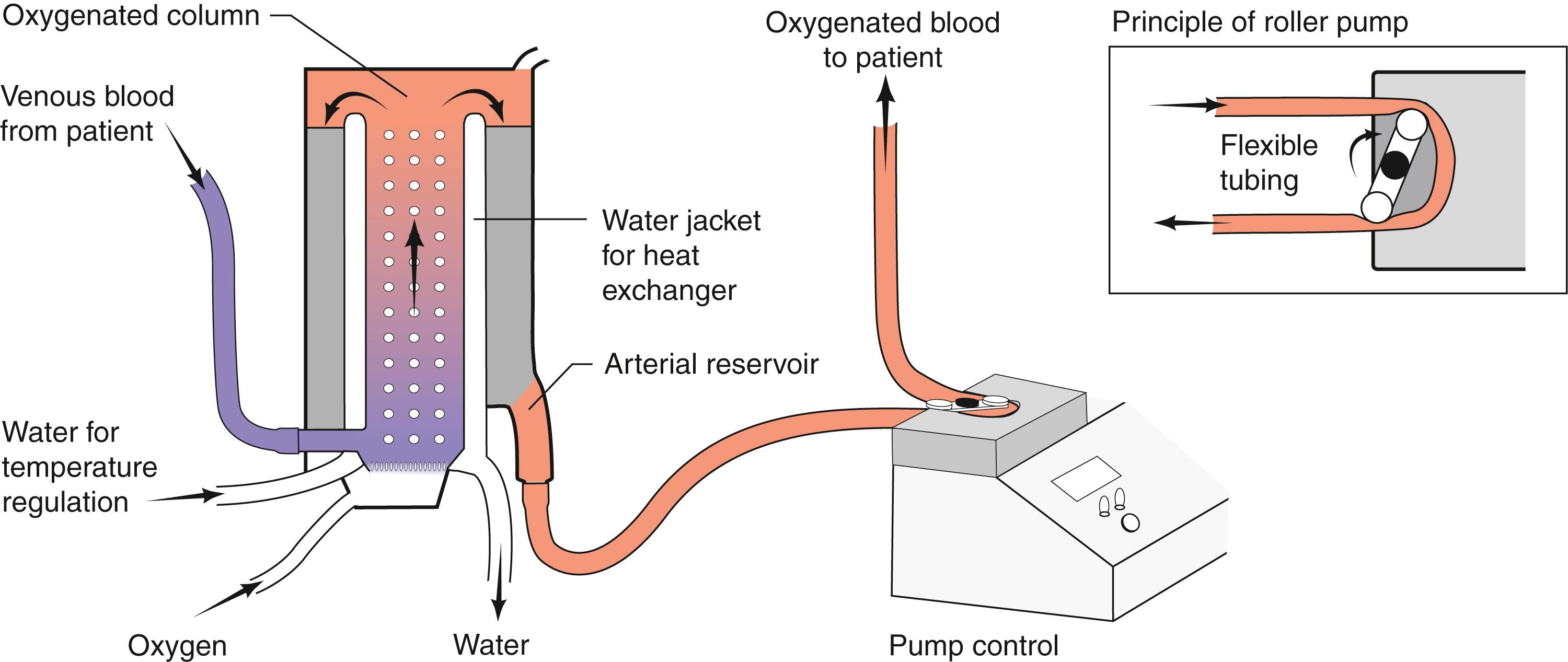
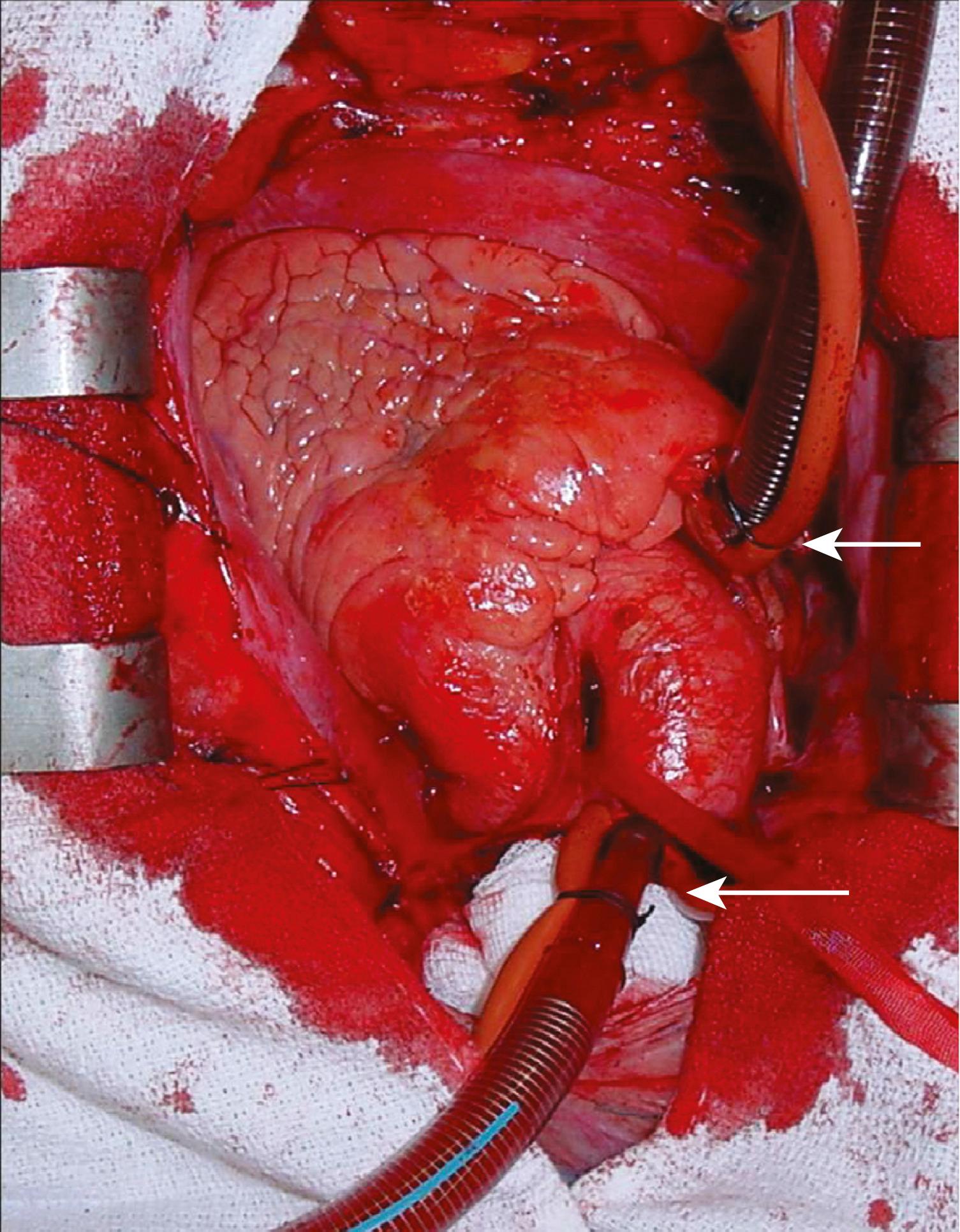
CPB stimulates a systemic inflammatory response mediated by cytokine release, complement activation and white cell activation. These changes do not generally cause clinical problems but may be implicated in postbypass pulmonary, renal and cerebral dysfunction. Cerebral damage occurs in about 1% of cases due to intracerebral bleeding, embolisation of microbubbles or arterial debris, or inadequate cerebral perfusion. Subtle deterioration in cerebral function, as detected by psychological testing, is more frequent. Coagulopathy and haemolysis are associated with prolonged bypass. Minicircuits have become more popular recently, which avoid haemodilution on CPB and may reduce the need for blood transfusion.
Cardioplegic diastolic arrest achieves a still, bloodless heart. A cross-clamp is applied across the ascending aorta proximal to insertion of the arterial inflow cannula. This prevents blood flow into the coronary arteries. The heart is arrested by perfusing the coronary circulation with a cardioplegic solution, delivered either antegradely via the aortic root or coronary artery ostia utilising the native coronary arteries, or retrogradely via a catheter placed in the coronary sinus.
The essential component of a cardioplegic solution is a high potassium concentration (circa 18 mmol/L), which causes the heart to arrest in diastole. Cardioplegia is typically delivered at a temperature of 4°C to 6°C as either a crystalloid solution or using the patient’s own blood as a vehicle. Blood-based solutions are believed to have abundant oxygen-derived free radical scavengers, as well as buffering characteristics that are helpful in reducing the deleterious effects of ischaemic metabolites generated by the arrested myocardium. Cardioplegia solutions minimise myocardial energy requirements by abolishing energy expenditure on contraction and reducing basal cellular metabolism with local tissue cooling. Reducing core temperature on bypass to 26°C to 34°C may enhance cardiac cooling. Cardioplegia combined with mild systemic hypothermia (32°C) provides the surgeon with a safe period of cardiac arrest of up to 120 minutes, permitting surgery while minimising the risk of myocardial damage.
Coronary artery bypass graft (CABG) surgery can be performed using a technique in which an aortic clamp is intermittently applied to cut coronary flow while the heart is electrically fibrillated to reduce movement. The resulting brief ischaemic episodes are tolerated. This cross-clamp fibrillation technique activates ischaemic preconditioning mechanisms within the myocardial cells that reduce damage caused by subsequent ischaemia.
In some circumstances, the surgeon may elect to leave the coronary arteries perfused while on bypass and operate on a beating heart. Recently there has been considerable interest in performing CABG on suitable patients without the use of CPB. Proponents of ‘off-pump’ surgery claim that risks of artificial perfusion are avoided and recovery may be quicker. Many surgeons, however, feel that the bloodless, still operative field resulting from cardioplegic arrest provides optimum conditions for high-quality accurate anastomoses supported by evidence of poorer distal anastomoses during ‘off-pump’ surgery.
Postoperatively, patients are usually ventilated for a few hours until they are fully rewarmed and have satisfactory stable haemodynamics, pulmonary gas exchange and acid-based status. Urine output is copious and potassium levels are, therefore, checked frequently so that potassium is administered intravenously to correct urinary losses. Invasive measurement of arterial and central venous pressure is standard. Pulmonary artery (PA) catheters may be used to measure PA pressure, PA capillary wedge pressure and cardiac output.
Other than death or stroke, established complications include:
Bleeding: multifactorial causes, including hypothermia, platelet dysfunction, CPB and pharmacologic (aspirin, clopidogrel), hyperfibrinolysis, heparin excess, complement and leucocyte activation, and reduced coagulation factors
Low cardiac output: inadequate perfusion, poor myocardial protection, previous poor left ventricular (LV) function, hypovolaemia, tamponade, etc.
Arrhythmias: atrial fibrillation occurs in up to 40% after CABG
Renal failure, hepatic failure, pulmonary failure
Infection: wound, respiratory
Short-term memory impairment, loss of concentration, intelligence, learning and dexterity
Patients undergoing routine elective coronary or valve surgery will usually leave acute hospital care within 1 week. Those requiring more extensive surgery or emergency procedures may take longer to recover. Most patients will have undergone a median sternotomy ( Fig. 23.4 ); this wound heals quickly and, as the sternal edges are approximated securely by wire or heavy sutures, chest discomfort eases rapidly. Leg vein donor sites may take longer to heal, particularly around the knee. By 2 weeks, the patient should be able to walk a few hundred metres, and by 3 months should have returned to full activity, including work.
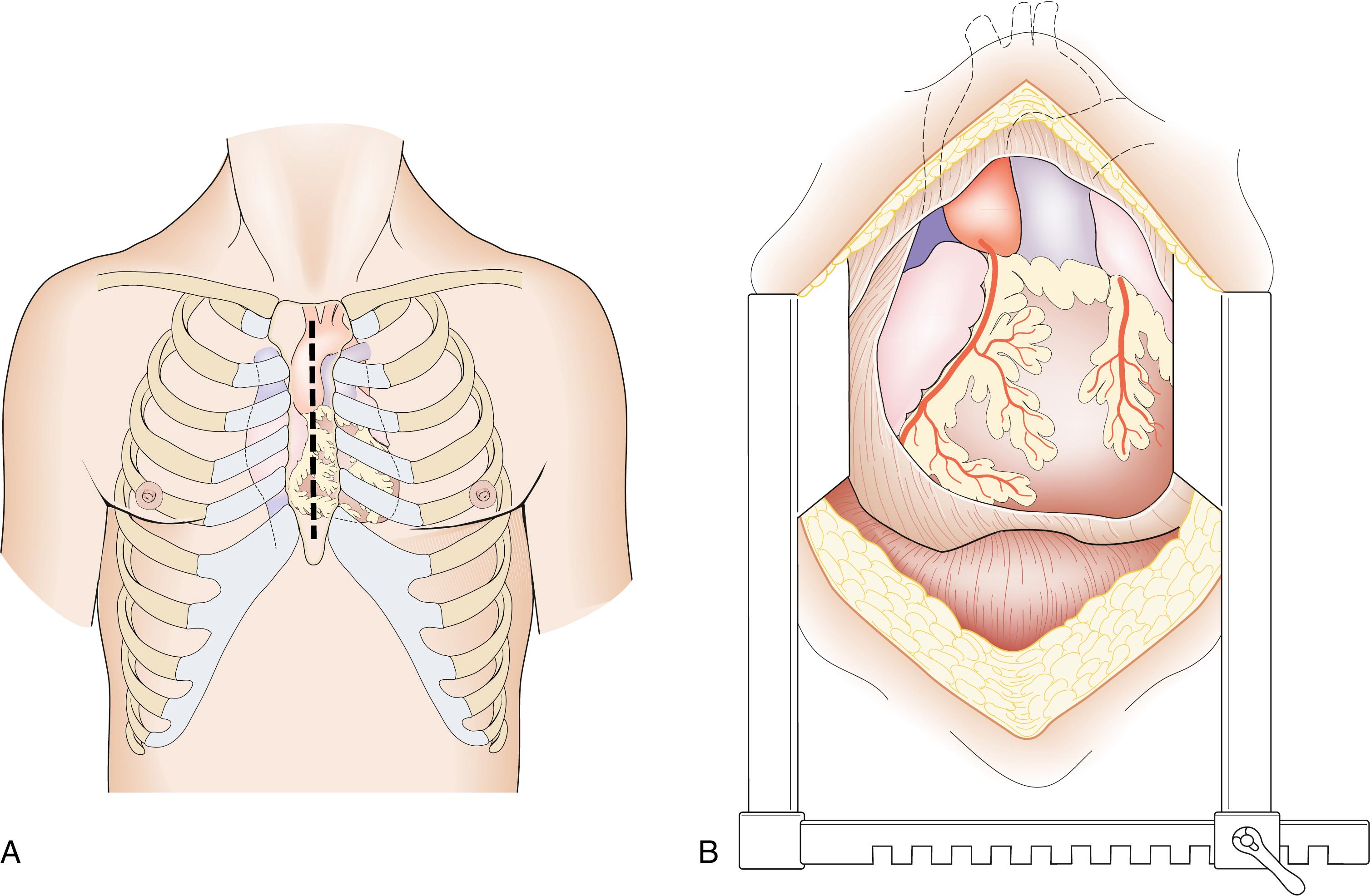
Surgical intervention may be required in the management of:
Ischaemic heart disease
Cardiac valvular disease
Aortic aneurysm
Pericardial pathology
Cardiac trauma
Ischaemic heart disease encompasses CAD and its complications, principally acute mitral regurgitation, ventricular septal defect, LV aneurysm and sudden death.
Coronary artery atheroma (see Chapter 22 ) results in narrowing of the vessels, and most patients will present for surgery because of angina, dyspnoea or previous myocardial infarction (MI).
Exercise electrocardiography (ECG) is often used as an initial screening test for patients with suspected stable angina. Those with confirmed ischaemia then undergo coronary angiography and assessment of LV function by means of angiography or echocardiography. Contrast medium is injected into the coronary circulation ( Fig. 23.5 ) via a catheter that is usually inserted through the femoral or radial artery ( Fig. 23.6 ). Images are obtained in several different planes so as to minimise the risk of missing eccentric lesions. Intervention is usually only advised for stenosis that exceeds a 50% reduction in vessel diameter on angiography, which equates to 75% cross-sectional stenosis.
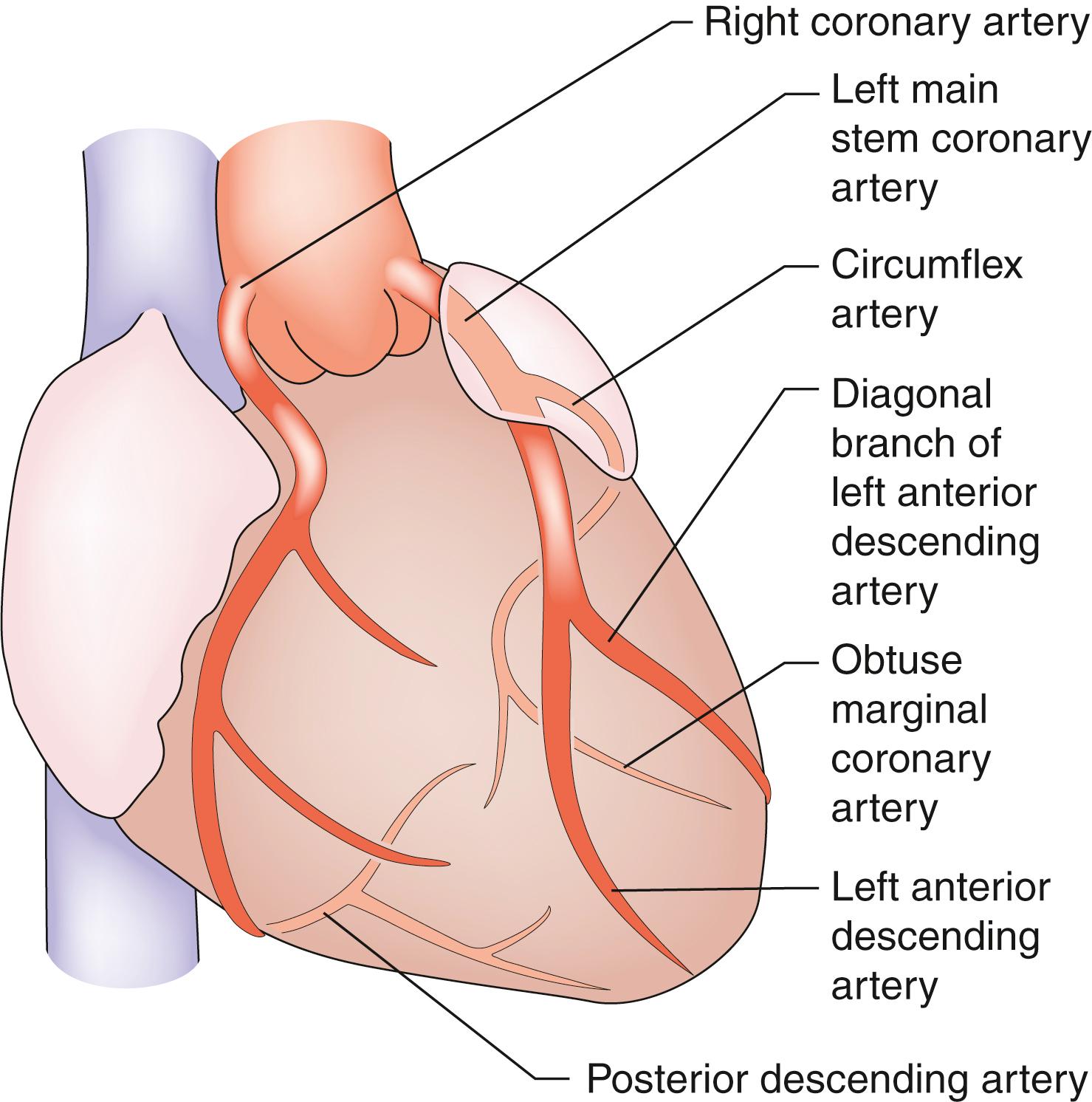
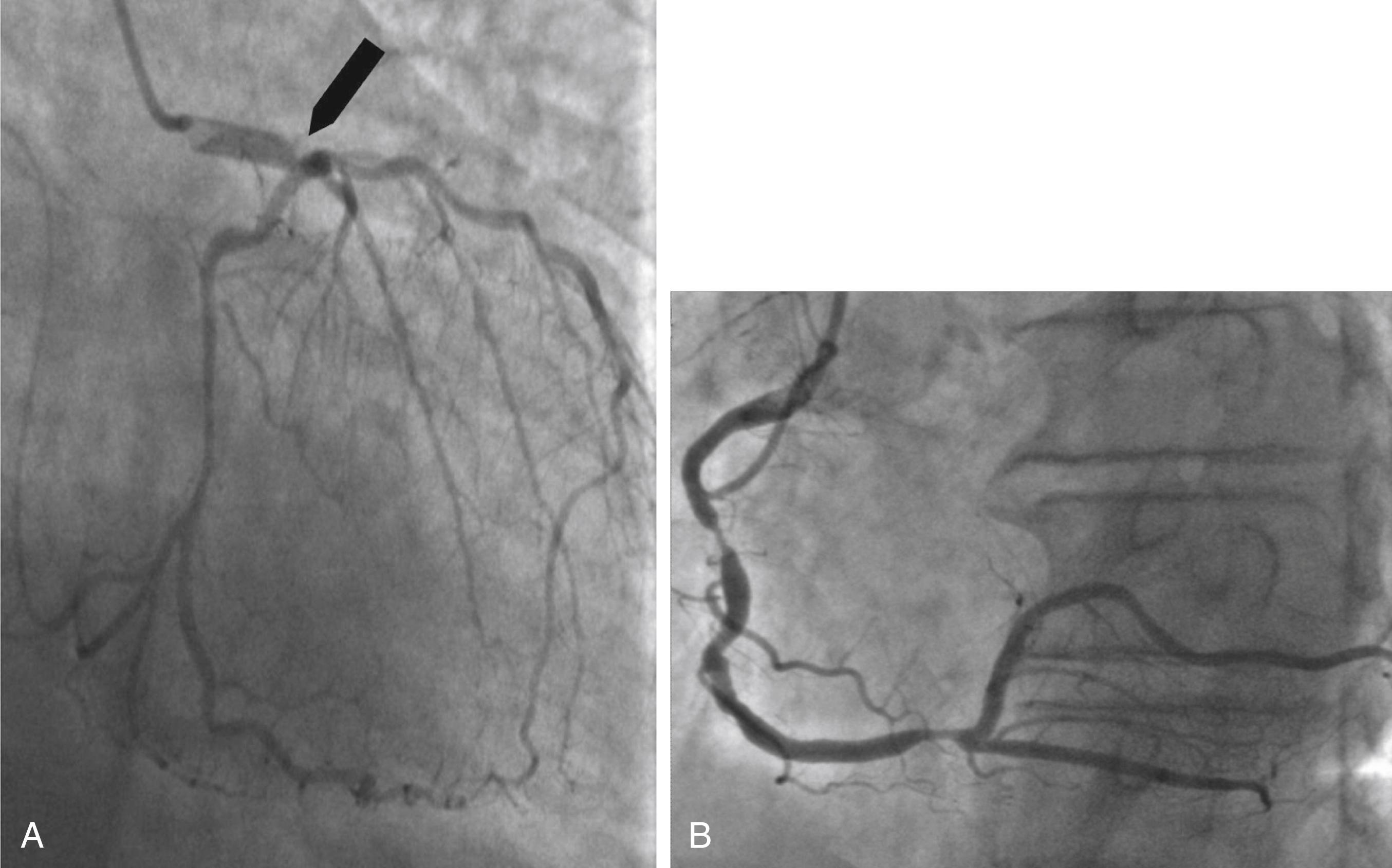
Elective surgery is indicated primarily for control of angina that is refractory to medical treatment and where surgery has been shown to be of more symptomatic and prognostic benefit to percutaneous intervention (PCI), usually with stent insertion. Historically, patients with three-vessel disease or left main stem disease have exhibited a high (circa 8% per year) risk of death from MI with medical therapy alone. Surgery improves long-term survival for such patients, particularly when LV function is also impaired or if they are diabetic. PCI has an important role in the management of patients with acute coronary syndrome, especially from ST elevation MI, where primary PCI has become the standard of care.
Some patients requiring other cardiac procedures may have significant coronary disease during cardiologic assessment. In these cases, coronary surgery may be done before the primary procedure to improve perioperative survival and prevent future ischaemic problems. However, this is only practiced if the patient has an indication for cardiac surgery. Emergency coronary surgery is rare, and patients with incipient or established MI fare better with PCI and supportive medical therapy, as the mortality of surgery in this setting has increased.
Coronary artery bypass graft (CABG) surgery aims to deliver blood to the distal coronary artery beyond a stenosis. If the distal artery is obliterated by atheroma, an endarterectomy procedure may be performed to restore the lumen. Originally, nearly all grafts comprised reversed segments of the long saphenous vein anastomosed proximally to the ascending aorta and distally to the coronary artery. Such grafts have patency rates of around 70% at 5 years and 40% at 10 years. Venous graft failure occurs as a result of intimal hyperplasia, which is thought to be, in part at least, a response to arterial pressure. The relatively high rate of vein graft failure stimulated interest in arterial grafts and led to the almost universal use of the internal thoracic artery (ITA) in more than 90% of CABG cases. This is usually employed as a pedicled graft when it is left attached to the subclavian artery proximally but can also be used as a free graft in the same manner as a vein. ITA graft patency exceeds 95% at 5 years and 90% at 10 years. A common combination is to use the left ITA for the left anterior descending artery and vein grafts for the other vessels ( Fig. 23.7 ). There have been recent calls to use both the right and left ITAs; however, this is associated with increased sternal complications and no survival benefit.
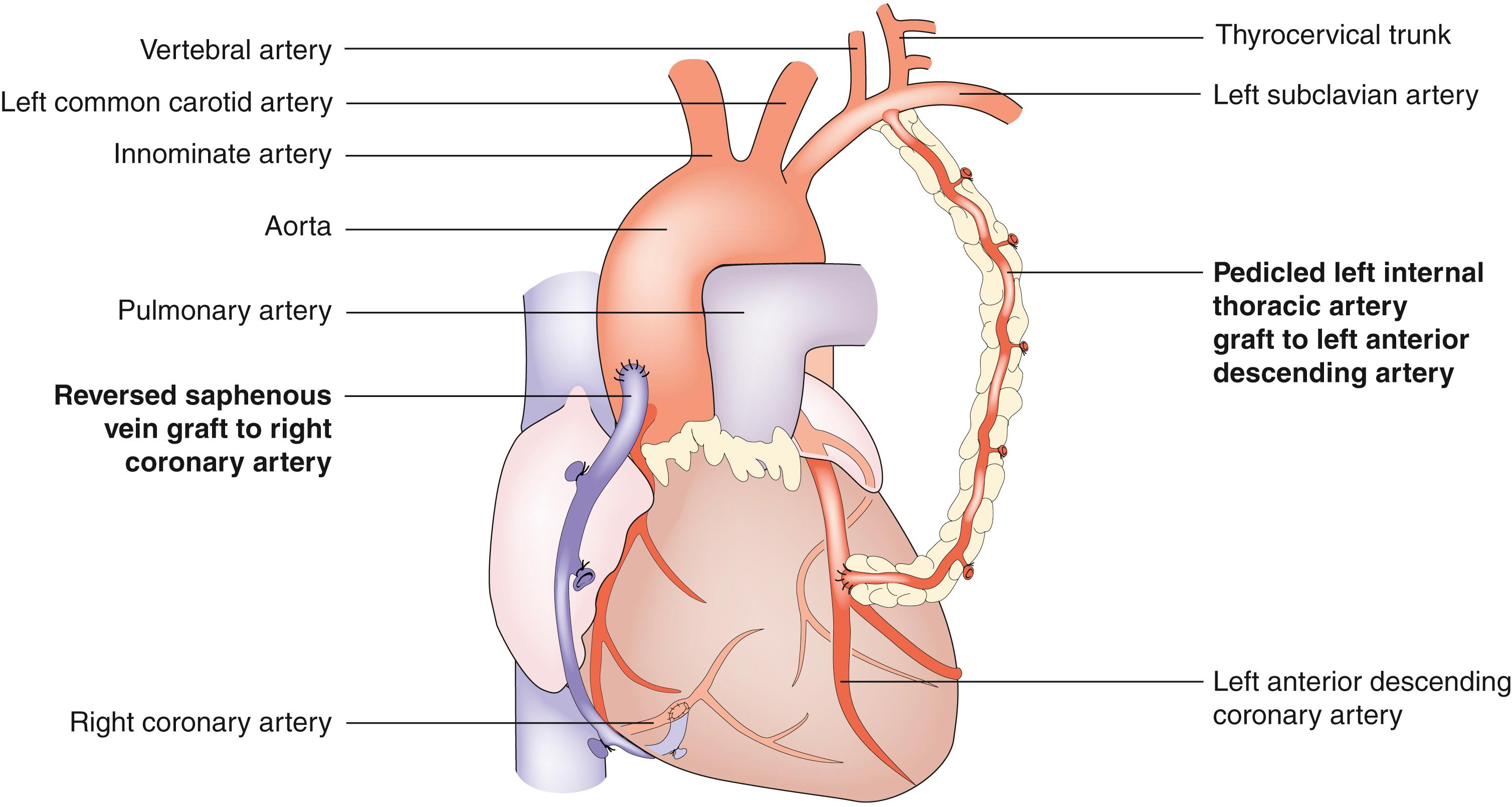
The radial artery is a possible option as a free graft for use in people with poor-quality saphenous veins and critical proximal occlusion of more than 70% in the target vessel, and may be used together with ITA grafts to achieve ‘total arterial revascularisation’. Occasionally, when there is a shortage of a good conduit, the surgeon may consider using the right gastroepiploic artery, the short saphenous vein or the cephalic vein. Prosthetic grafts occlude early and are not used.
Elective coronary surgery in the UK carries a risk of mortality of 0.6% and a 1% to 2% risk of stroke, while emergency surgery has a mortality of 6% despite increasing age and comorbidity of patients. Angina is relieved completely in about 70% of cases, is significantly improved in the remainder and recurs with a frequency of about 10% per year. Successful revascularisation may also improve breathlessness if it is related to myocardial ischaemia, and survival is enhanced in patients with left main stem and triple vessel disease. The use of arterial conduits is associated with better graft patency and improved survival. Although there is a trend in that direction for patients with multiple arterial grafts followed up beyond 10 years, the added benefit over one
Revascularisation has been shown to improve survival in patients with:
Left main stem disease
Proximal LAD stenosis > 50%
Two- or three-vessel disease with stenosis > 50% and impaired left ventricle function
Large area of ischaemia detected by functional testing
Single remaining patent vessel with stenosis > 50%
Revascularisation can be considered for symptomatic relief in the presence of significant coronary artery disease and failure of full medical therapy
Secondary prevention includes lifelong aspirin, beta-blockers, ACE inhibitors and a statin if the patient has hypercholesterolemia
ITA graft placed to the left anterior descending coronary is small. This may reflect the progression of native coronary disease. Secondary prevention is mandatory in all patients with CAD and includes antiplatelet medications (aspirin), cholesterol reduction (statin), beta-blocker and ACE inhibitor ( EBM 23.1 ).
There are two coronary arteries (left and right) that have their origin in the coronary sinuses: left or posterior sinus, right or anterior sinus.
The left main coronary artery passes behind the pulmonary trunk and divides into two large branches: the left anterior interventricular artery or left anterior descending (LAD), which supplies the anterior left ventricle and anterior two-thirds of the interventricular septum, and the circumflex coronary, which supplies the posterior and lateral walls of the left ventricle.
The right coronary artery passes down anteriorly in the right atrioventricular groove supplying the anterior right ventricle and acute marginal branches.
Either the right (85%), circumflex (10%) or both (5%) may terminate as the posterior descending artery, which supplies the inferior surface of both ventricles and the lower septum. This artery is then considered to be dominant or codominant.
The right, LAD and circumflex are each considered to be a ‘vessel system’. Disease within any one of these three vessels or its branches is termed single-vessel disease. Similarly, two- and three-vessel disease indicates involvement of two and three systems, respectively.
Chronic ischaemia may cause MR, owing to papillary muscle fibrosis. Surgery may be indicated to repair or replace the valve as an elective procedure, usually concurrently with CABG. The operative mortality is approximately 8% to 11%.
Acute MI involving a papillary muscle may cause this to rupture, resulting in gross regurgitation. The patient is usually very unwell with pulmonary oedema due to MR and low cardiac output due to infarction, and often requires emergency ventilation. Emergency mitral valve replacement and CABG is associated with a mortality of 15% to 40%, mainly due to poor ventricular function and secondary multiorgan failure.
Necrosis of the intraventricular septum due to MI may lead to a ventricular septal defect. Blood flows from the high-pressure left to the low-pressure right ventricle (left-to-right ‘shunt’). This increases right ventricular work and pulmonary blood flow and decreases cardiac output. Typically, the patient complains of sudden, severe breathlessness 3 to 8 days after an MI and is noted to have developed a pansystolic murmur. The diagnosis is confirmed by echocardiography, and coronary angiography is performed. Emergency repair is technically difficult due to the poor quality of the recently infarcted muscle to which the patch is attached. In addition, these patients have impaired cardiac function in the aftermath of an acute MI. Typically, such patients will require mechanical support of their ventricle with an intraaortic balloon pump. Surgical mortality ranges from 20% to 50%. Patients with minor shunts are managed medically and may be considered for surgery some weeks later to allow cardiac function to stabilise. The margins of the defect will have healed by fibrosis, making patch repair relatively straightforward with more acceptable operative mortality (<10%).
LV aneurysm complicates about 8% of MIs and occurs when a large LV free-wall MI scar becomes aneurysmal because of intraventricular pressure. A large aneurysm impairs cardiac contraction and increases myocardial work. Complications include clot formation within the aneurysm that may embolise and arrhythmias generated within the zone of ischaemic myocardium around the periphery of the aneurysm.
At operation, the aneurysm is excised, the clot removed and the resulting defect usually closed by direct suture, reinforced by buttressing strips of Teflon felt or vascular graft. Occasionally, a small patch repair is performed to preserve the shape of the left ventricle. Surgery performed electively has a mortality of 6% to 10% and an increased risk of stroke.
Valve disease may obstruct forward flow (stenosis), permit reverse flow (incompetence/regurgitation) or both. The aortic and/or mitral valves are primarily affected; primary tricuspid pathology is rare, and pulmonary valve disease is virtually unknown. Formerly, rheumatic fever following streptococcal infection was the most common aetiologic factor. This remains the case in many developing countries but is rare in the Western world.
Become a Clinical Tree membership for Full access and enjoy Unlimited articles
If you are a member. Log in here